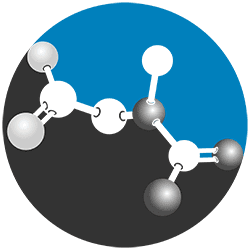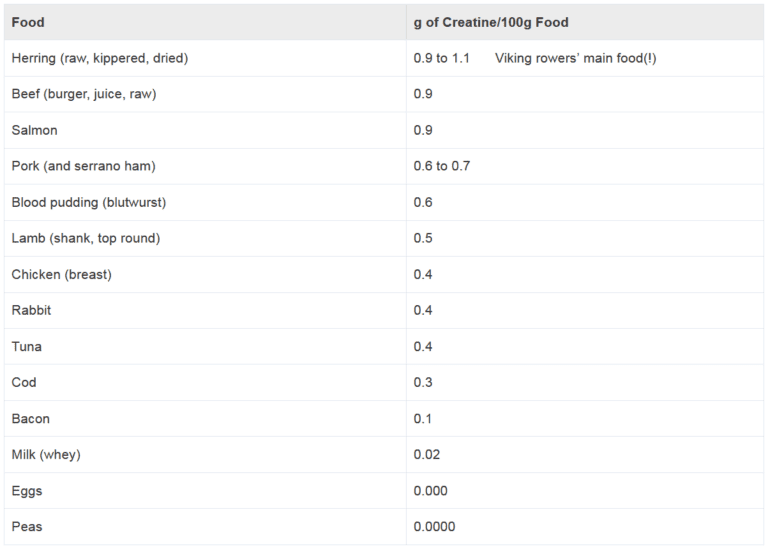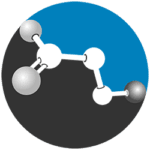Creatine Monohydrate
Old School Phosphate Scavenging and Acid Management
Better for Your sizzle
Creatine as a biochemical substance has been known since the 1830s, and Creatine Monohydrate has been noticed as a substantial dietary supplement since the 1970s. Many studies have looked at the efficacy of Creatine at managing the acid products of muscle work. It operates on entirely different mechanism than Leucine support molecule HMB. Dietary Creatine does not appear to increase new muscle protein synthesis or slow muscle protein breakdown (see Veggi et al. below, however). This is why Strenduro is a 3-ingredient product. (see HMB)
It has been an unpatented ingredient for a long time. As with many nutritional ingredients, Creatine Monohydrate is produced by many laboratories, and so the quality of the source can vary quite a bit. It has been said: The lowest price ingredient is typically not the highest performing ingredient. Sometimes the powder or crystals of Creatine Monohydrate are very large or more granular and insoluble. Sometimes the price is impossibly low. It really makes you think. At Clean Energy Foods, we do our best to identify long-term product vendors with quality standards that ensure a flowing, mixable Formula 456 that is clearly high-purity Creatine Monohydrate.
Other companies have tried for a long time to generate some exclusivity for different versions of Creatine, by solubilizing them with different combinations of food acids or alkaline, trying to differentiate from “Monohydrate.” They have sought exclusivity with patents and conducted studies to attempt to demonstrate that their version of Creatine is absorbed better, or dissolves better (not the same thing) and cause major performance changes that are better than Creatine Monohydrate. While some of the studies show promise, none generate such crazy and obvious benefits that the whole market is abandoning Creatine Monohydrate in favor of the new guy. Indeed, Creatine Monohydrate is the undisputed ruler, the generic Gold Standard as it were. It is a straightforward stable ingredient that delivers on it’s promises. Our supplier has been making and selling this high grade of Creatine Monohydrate for over 30 years.
PLEASE NOTE: Other companies may mean well with their product offerings, but unfortunately, sometimes they miss. An example of this is the format of the liquid Creatine. Creatine is very stable as a Monohydrate powder and generally stable while in living systems that offer a protective cellular enzymatic environment and ready usage of the molecule. Storing Creatine in any amount of water leads to rapid non-enzymatic degradation. (Creatine + Water = Sarcosine + Urea, please feel free to look it up.) The Sarcosine product is meaningless in the context of muscular performance, and lends nothing; everybody knows Urea is waste. Indeed, several studies have shown that liquid formats (with unknown storage times, but probably more than a few weeks) have resulted in zero measurable gains when compared with powdered Creatine Monohydrate. You may be able to get away with Creatine powder freshly mixed with water on your kitchen counter for maybe 24-72 hours before the degradation is noticeable, but your best bet is to make fresh beverage from powder before each use.
SOME Creatine RESEARCH

- Sahlin et al., "Muscle energetics during explosive activities and potential effects of nutrition and training." (2014) Sports Med.
- Harris, et al. "Glycogen, glycolytic intermediates and high-energy phosphates determined in biopsy samples of musculus quadriceps femoris of man at rest. Methods and variance of values." (1974) Scand. J. Clin. Lab. Invest.
- Harris et al., "Elevation of creatine in resting and exercised muscle of normal subjects by creatine supplementation." (1992) Clin. Sci.
- Rawson, et al., "Effects of creatine supplementation and resistance training on muscle strength and weightlifting performance." (2003) J. Strength Cond. Res.
- Engelhardt, et. al., "Creatine supplementation in endurance sports." (1998) Med. Sci. Sport Exer.
- Vandebuerie, et al., "Effect of creatine loading on endurance capacity and sprint power in cyclists." (1998) Int. J. Sports Med.
- Tomcik, et al., "Effects of creatine and carbohydrate loading on cycling time trial performance." (2018) Med. Sci. Sports Exerc.
- Lanhers, et al., "Creatine supplementation and lower limb strength performance: a systematic review and meta-analyses." (2015) Sports Med.
- Lanhers, et al., "Creatine supplementation and upper limb strength performance: a systematic review and meta-analysis." (2017) Sports Med.
- van Loon et al., "Effects of creatine loading and prolonged creatine supplementation on body composition, fuel selection, sprint and endurance performance in humans." (2003) Clin. Sci.
- Greenhaff, et al., "Effect of oral creatine supplementation on skeletal muscle phosphocreatine resynthesis." (1994) Am. J. Physiol.
- Veggi, et al., "Oral creatine supplementation augments the repeated bout effect." (2013) Int. J. Sport Nutr. Exerc. Metab.

THE Other Ingredients
HMB
Recovery is made simple. daily.
Branch Chain Amino Acid (BCAA) support begins with Leucine and ends with HMB.
Research has shown that HMB supports recovery.
BETA-ALANINE
gets in, makes carnosine happen.
Working muscle breaks down ATP. This process makes acid (the sizzle). The only way to manage acid is to pick up ATP breakdown products. Muscles rely on Carnosine to scavenge those breakdown products and control the sizzle.

Creatine rich foods

Some people say: “Oh I don’t need supplements, I eat a balanced diet.” And this is a good healthy instinct considering that the whole foods you eat can supplement the Creatine that you are um…. supplementing!
As you can see, to get ~5 grams of daily added Creatine from diet, it would take around 500 grams (1.1 pounds) of Herring to get you there. Or about 1.25 pounds of beef or salmon. Or 1.6 pounds of pork or 2.2 pounds of lamb. Chicken breast, rabbit and tuna will get you 5 grams of Creatine if you consume 2.75 pounds per day. Cod will require 3.7 pounds per day. Bacon? 11 pounds per day. Milk will need 55 pounds per day or about 6.6 gallons IF they were not measuring from dry milk solids. (!) Whey, Eggs, and Peas add literally nothing to the dietary Creatine profile: it is absent in these foods.
The point is, if you are eating a lot of protein in the way of fish and farm meats, you will be getting some Creatine and some Leucine. This is good for the athlete. However, most people, even dedicated athletes, are not eating a pound of any meat daily. The convenient solution to obtain the best-researched endurance ingredient is to use powder-form Creatine Monohydrate. We humbly suggest that Strenduro Formula 456 is a solid choice.

